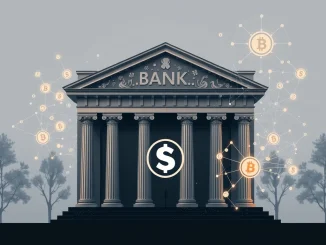
Get ready for a potential seismic shift in the crypto landscape! Whispers are turning into roars as top analysts at Bernstein predict 2025 could be the year the U.S. finally lays down the regulatory framework for stablecoins. Imagine a world where stablecoins are seamlessly integrated into our financial system, backed by clear rules and driving innovation. This isn’t just wishful thinking; Bernstein believes a ‘perfect storm’ is brewing in Washington, D.C., ready to unleash a wave of stablecoin regulation.
Why 2025 Could Be a Landmark Year for US Stablecoin Regulation?
Bernstein’s report paints a compelling picture of converging forces pushing for US stablecoin regulation. Let’s break down why they believe 2025 is the magic number:
- White House Support: The current administration is increasingly recognizing the strategic importance of digital assets, particularly stablecoins, in maintaining U.S. financial leadership. This backing from the executive branch is crucial for legislative momentum.
- Republican-Led Congress: Surprisingly, there’s growing bipartisan consensus on the need for crypto clarity. A Republican-led Congress, while often seen as skeptical of crypto, also recognizes the potential economic benefits and the need to regulate the space effectively. This unusual alignment creates fertile ground for bipartisan legislation.
- Pro-Crypto Agency Heads: Key regulatory agencies are now headed by individuals who understand the nuances of the crypto industry and are open to fostering innovation while ensuring consumer protection. This shift in regulatory leadership is paving the way for pragmatic and forward-thinking regulations.
This confluence of political will and regulatory understanding is what Bernstein terms a “perfect storm,” suggesting that 2025 stablecoin legislation isn’t just possible – it’s highly probable.
The Booming Role of Stablecoins: Beyond Crypto Trading
Why is all this regulatory attention focused on stablecoins? It’s because their utility is rapidly expanding beyond the typical crypto trading arena. Bernstein’s report highlights several key areas where stablecoins are making significant strides:
- Cross-Border Payments Revolution: Stablecoins offer a faster, cheaper, and more efficient way to send money across borders, disrupting traditional remittance systems and empowering global commerce. Imagine sending money to family overseas in seconds, with minimal fees – stablecoins are making this a reality.
- B2B Transactions: Businesses are starting to realize the benefits of using stablecoins for transactions, streamlining supply chains, reducing settlement times, and lowering costs. From paying suppliers to managing international invoices, stablecoins are offering a compelling alternative to traditional banking rails.
- AI-Driven Payments: As artificial intelligence becomes more integrated into our lives, stablecoins are emerging as a natural fit for automated and micro-payments within AI ecosystems. Think machine-to-machine payments, automated subscriptions, and seamless transactions within smart contracts – stablecoins are powering the future of AI-driven economies.
These diverse use cases underscore why crypto regulation, specifically around stablecoins, is no longer just a niche issue for crypto enthusiasts – it’s becoming a mainstream economic imperative.
US Dollar Dominance and the Digital Dollar Debate
The Bernstein report also touches upon a crucial geopolitical aspect: the role of stablecoins in maintaining U.S. dollar dominance. In an increasingly digital world, the future of global finance is intertwined with digital currencies. Stablecoins, predominantly pegged to the U.S. dollar, can act as digital ambassadors, reinforcing the dollar’s influence in the global economy.
This brings us to the broader conversation about a digital dollar. While stablecoins are privately issued, regulated stablecoins could be seen as a stepping stone towards a central bank digital currency (CBDC). The regulatory framework developed for stablecoins could inform and potentially accelerate the development and adoption of a U.S. CBDC in the future.
Traditional Finance Embracing Stablecoins?
One of the most exciting prospects highlighted in the report is the potential for traditional financial institutions to jump into the stablecoin space once clear regulations are in place. Banks, payment processors, and other financial giants are likely waiting on the sidelines for regulatory clarity before fully embracing stablecoin issuance and settlement.
Imagine major banks offering their own regulated stablecoins, seamlessly integrated into their existing infrastructure. This could unlock massive liquidity, drive mainstream adoption, and further legitimize the crypto space within traditional finance.
Stablecoin Issuers: Unexpected Treasury Giants
Here’s a fascinating detail: Bernstein points out that stablecoin issuers are now becoming significant holders of U.S. Treasuries. Why is this important? Because it further intertwines stablecoins with the traditional financial system and adds another layer of urgency for regulatory oversight.
As stablecoin reserves are largely held in U.S. Treasuries and other low-risk assets, these issuers are effectively becoming major players in the government bond market. This increased financial interconnectedness underscores the need for robust stablecoin regulation to ensure financial stability and protect the broader economy.
Challenges and the Path Forward
While the outlook for 2025 stablecoin regulation is optimistic, challenges remain. Key areas that regulators will need to address include:
- Interoperability: Ensuring different stablecoins can seamlessly interact with each other and with traditional financial systems.
- Consumer Protection: Establishing robust frameworks to protect users from fraud, manipulation, and loss of funds.
- Anti-Money Laundering (AML) and KYC: Implementing effective measures to prevent illicit activities and ensure compliance with financial regulations.
- Reserve Transparency and Auditing: Requiring stablecoin issuers to maintain transparent reserves and undergo regular audits to ensure peg stability.
Addressing these challenges effectively will be crucial for building a safe, robust, and innovative stablecoin ecosystem in the U.S.
Actionable Insights: What Does This Mean for You?
Whether you are a crypto investor, a business owner, or simply someone curious about the future of finance, the impending US stablecoin regulation has implications for you:
- For Crypto Investors: Regulatory clarity is generally positive for the long-term health of the crypto market. Keep an eye on regulatory developments and consider how stablecoin adoption might impact your portfolio.
- For Businesses: Explore the potential of stablecoins for your operations, particularly for cross-border payments and B2B transactions. Start planning for potential integration once regulations become clearer.
- For Everyone: Stay informed about the evolving digital finance landscape. Stablecoins and digital dollar initiatives are shaping the future of money and will impact us all.
Conclusion: The Dawn of Regulated Stablecoins?
Bernstein’s prediction of a revolutionary 2025 for US stablecoin regulation is a compelling narrative. The stars seem to be aligning for significant legislative progress, potentially ushering in a new era of regulated stablecoin adoption. This could not only legitimize the crypto space further but also unlock immense potential for innovation, economic growth, and the continued dominance of the U.S. dollar in the digital age. Keep watching this space – 2025 could be a game-changer for stablecoins and the entire financial world.



